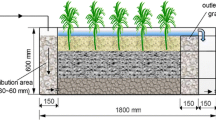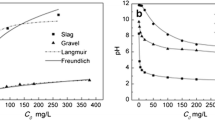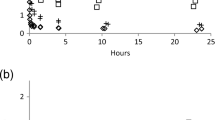Abstract
Constructed wetland (CW) is a promising technique for removal of pollutants from wastewater and agricultural runoff. The performance of a CW to remove pollutants, however, hinges on the use of suitable substrate materials. This study examined the physicochemical properties and phosphorus (P) sorption capacities of nine different CW substrate materials using both batch experiments and the Freundlich as well as the Langmuir isotherm. The nine substrate materials used in this study were turf, topsoil, gravel, midsized sand (MSS), blast furnace slag (BFS), coal burn slag (CBS), blast furnace artificial slag (BFAS), coal burn artificial slag (CBAS), and midsized artificial sand (MSAS). Experimental data showed that sorption of P increased with initial solution P concentrations for all nine substrate materials. The maximum P sorption capacity of the substrate materials estimated by Langmuir isotherm was in the following order: turf (4243 mg/kg substrate) > BFAS (2116 mg/kg substrate) > BFS (1598 mg/kg substrate) > CBS (1449 mg/kg substrate) > top soil (1396 mg/kg substrate) > CBAS (1194 mg/kg substrate) > MSAS (519 mg/kg substrate) > gravel (494 mg/kg substrate) > MSS (403 mg/kg substrate). The specific gravity of eight substrate materials (except gravel) had very significant negative correlations with the P sorption, whereas the particle diameter of D60 and uniformity coefficient (K60) had positive correlations with the P sorption. The cation exchange capacity, organic matter, available ferrous, and exchangeable aluminum of the eight substrate materials also had very significant positive correlations with the P sorption, while the pH of the substrate materials showed a very significant negative correlation with the P sorption. Our study further suggests that turf and CBAS are the two relatively ideal substrate materials suitable for removal of P from a CW system.



Similar content being viewed by others
References
Arias CA, Bubba MD, Brix H (2001) Phosphorus removal by sands for use as media in subsurface flow constructed reed beds. Water Res 35(3):1159–1168
Arias CA, Brix H, Johansen NH (2003) Phosphorus retention from municipal wastewater in an experimental two-stage vertical flow constructed wetland system equipped with a calcite filler. Water Sci Techno 48(5):51–58
Bhuiyan LR Jr, Sedberry JE (1995) Phosphorus sorption characteristics of selected soils of Louisiana. Commun Soil Sci Plant Anal 26(7–8):1059–1072
Breen PF (1990) A mass balance method for assessing the potential of artificial wetland for wastewater treatment. Water Res 24(6):689–697
Brooks AS, Rozenwald MN, Geohring LD, Lion LW, Steenhuis TS (2000) Phosphorus removal by wollastonite: a constructed wetland substrate. Ecol Eng 15:121–132
Bruce RC, Rayment GE (1982) Analytical methods and interpretations used by the Agricultural Chemistry Branch for soil and land use surveys. Queensland Department of Primary Industries Bulletin QB82004
China Patent No. ZL012358797 (2002) Constructed flower bed for sewage treatment
Cui LH, Luo SM, Zhu XZ, Liu YH (2002) Treatment of septic tank effluent using vertical-flow constructed wetlands. Wetland and remediation. II. In: Proceedings of the Second International Conference on Wetlands and Remediation. Battelle Press, online, pp 225–234
Cui LH, Zhu XZ, Luo SM (2007) The relationship between constructed wetland substrate phosphorus adsorption character and its physico-chemical properties. China Environ Sci 27(2):250–254
Del Bubba M, Arias CA, Brix H (2003) Phosphorus adsorption maximum of sands for use as media in subsurface flow constructed reed beds as measured by the Langmuir isotherm. Water Res 37:3390–3400
Drizo A, Frost CA, Grace J, Smith KA (1999) Physico-chemical screening of phosphate-removing substrates for use in constructed wetland systems. Water Res 33(17):3595–3602
Forbes MG (2002) Phosphorus retention and fractionation in masonry sand light weight expanded shale used as substrate in a subsurface flow wetland. PhD dissertation. University of North Texas, Denton
Gray S, Kinross J, Read P, Marland A (2000) The nutrient assimilative capacity of maerl as a substrate in constructed wetland systems for waste treatment. Water Res 34(8):2183–2190
Johansson L (1997) The use of LECA (light expanded clay aggregrates) for the removal of phosphorus from wastewater. Water Sci Technol 35(5):87–93
Kadlec RH, Knight RL (1996) Treatment wetlands. Lewis, CRC Press, Boca Raton, FL, pp 70–73
Kuzawa K, Jung Y-J, Kiso K, Yamada T, Nagai M, Lee T-G (2006) Phosphorus removal and recovery with a synthetic hydrotalcites as an adsorbent. Chemosphere 62:45–52
Mann RA, Bavor HJ (1993) Phosphorus removal in constructed wetlands using gravel and industrial waste substrata. Water Sci Technol 27:107–113
Masbough A, Frankowskic K, Hallb JK, Duffd SJB (2005) The effectiveness of constructed wetland for treatment of woodwaste leachate. Ecol Eng 25:552–566
McEldowney S, Hardman DJ, Waite S (1993) Pollution: ecology and biotreatment. Longman Science and Technology, London
Mead JA (1981) A comparison of the Langmuir, Freundlich and Temkin equations to describe phosphate adsorption properties of soils. Aust J Soil Res 19:333–342
Pall R, Mohsenin N (1980) A soil air pycnometer for determination of porosity and particle density. Trans ASAE 23:735–741, 745
Pant HK, Reedy KR, Lemon E (2001) Phosphorus retention capacity of root bed media of sub-surface flow constructed wetlands. Ecol Eng 17:345–355
Peech M, Alexander LT, Dean LA, Reed JF (1947) Soil survey laboratory methods 1996. Soil Survey Investigations Report No. 42. USDA, Washington, DC
Ryden JC, Mclaughlin JR, Syers JK (1977) Mechanisms of phosphate sorption by soils and hydrous ferric oxides gel. J Soil Sci 28:72–92
Sakadevan K, Bavor HJ (1998) Phosphate adsorption characteristics of soils, slag and zeolite to be used as substrates in constructed wetland systems. Water Res 32(2):393–399
Vymazal J (1999) Removal of phosphorus in constructed wetlands with horizontal sub-surface flow in the Czech Republic. In: Vymazal J (ed) Nutrient cycling and retention in natural and constructed wetlands. Backhuys, Leiden, The Netherlands, pp 1–17, 73–83
Walkley A (1947) A critical examination of a rapid method for determining organic carbon in soils—effect of variations indigestion conditions and of inorganic soil constituents. Soil Sci 63:251–264
Wang RZ (1989) Soil particle density, bulk density and porosity determination; soil particle analyses; soil moisture determination. In: Li UK (eds) Routine methods of agro-chemistry and soil. Agro-chemistry Committee of Chinese Society of Soil Science Science Press, Beijing, pp. 15–66
Zhu T, Jenssen PD, Machlum T, Krogstad T (1997) Phosphorus sorption and chemical characteristics of lightweight aggregates (LWA): potential filter media in treatment wetlands. Water Sci Technol 35(5):103–108
Xu DF, Xu JM, Wu JJ, Muhammad A (2006) Studies of phosphorus sorption capacity of substrates used in constructed wetland systems. Chemosphere 63:344–352
Acknowledgments
This study was supported by grants from the National Natural Science Foundation of China (No. 40571074), the Natural Science Foundation of Guangdong Province (No. 04020599), the Key Project of Guangdong Province (No. 2003C32912), and the Key Project of Dongguan City of Science and Technology (No. 2006168402).
Author information
Authors and Affiliations
Corresponding author
Rights and permissions
About this article
Cite this article
Cui, L., Zhu, X., Ma, M. et al. Phosphorus Sorption Capacities and Physicochemical Properties of Nine Substrate Materials for Constructed Wetland. Arch Environ Contam Toxicol 55, 210–217 (2008). https://doi.org/10.1007/s00244-007-9109-y
Received:
Accepted:
Published:
Issue Date:
DOI: https://doi.org/10.1007/s00244-007-9109-y




